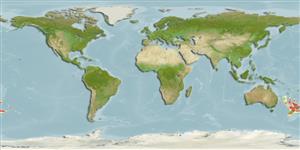Environment: milieu / climate zone / depth range / distribution range
Ekologi
marina bentopelagisk; djupintervall 0 - 1171 m (Ref. 12965). Temperate
Southwest Pacific: New Zealand (Ref. 5755) and Australia (Ref. 75154).
Size / Vikt / Age
Maturity: Lm ? range ? - ? cm
Max length : 40.0 cm TL hane/ej könsbestämd; (Ref. 126633)
A benthic species found on the continental slope (Ref. 75154). Holotype collected in 1171-1159 m (Ref. 12965). Minimum depth reported from Ref. 57178.
Life cycle and mating behavior
Könsmognad | Reproduktion | Lek | Ägg | Fecundity | Larver
Cohen, D.M., T. Inada, T. Iwamoto and N. Scialabba, 1990. FAO species catalogue. Vol. 10. Gadiform fishes of the world (Order Gadiformes). An annotated and illustrated catalogue of cods, hakes, grenadiers and other gadiform fishes known to date. FAO Fish. Synop. 125(10). Rome: FAO. 442 p. (Ref. 1371)
IUCN Red List Status (Ref. 130435: Version 2024-1)
Threat to humans
Harmless
Human uses
Verktyg
Special reports
Download XML
Internet-källor
Estimates based on models
Preferred temperature (Ref.
123201): 7.9 - 14.1, mean 11.5 °C (based on 63 cells).
Phylogenetic diversity index (Ref.
82804): PD
50 = 0.5001 [Uniqueness, from 0.5 = low to 2.0 = high].
Bayesian length-weight: a=0.01000 (0.00244 - 0.04107), b=3.04 (2.81 - 3.27), in cm total length, based on all LWR estimates for this body shape (Ref.
93245).
Trofisk nivå (Ref.
69278): 3.1 ±0.1 se; based on size and trophs of closest relatives
Fishing Vulnerability (Ref.
59153): Low to moderate vulnerability (30 of 100).
